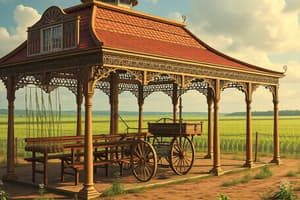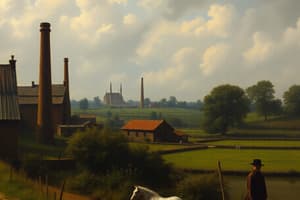Podcast
Questions and Answers
Which of the following describes the primary change in land ownership during the Agricultural Revolution?
Which of the following describes the primary change in land ownership during the Agricultural Revolution?
- Land was consolidated under the control of the Church.
- Land ownership shifted from individuals to the government.
- Land was redistributed equally among all citizens.
- Common land was privatized and enclosed. (correct)
How did Jethro Tull's seed drill contribute to increased agricultural productivity?
How did Jethro Tull's seed drill contribute to increased agricultural productivity?
- By eliminating the need for plowing fields.
- By attracting birds to help with seed distribution.
- By evenly scattering seeds on the surface of the soil.
- By drilling holes at the correct depth, planting seeds, and covering them. (correct)
What was a significant consequence of the increased crop yields during the Agricultural Revolution?
What was a significant consequence of the increased crop yields during the Agricultural Revolution?
- A surplus of agricultural labor, leading to migration to urban areas. (correct)
- A greater reliance on manual labor in agriculture.
- A decline in the quality of crops produced.
- A decrease in the overall population due to famine.
How did the discovery of legumes impact crop rotation practices?
How did the discovery of legumes impact crop rotation practices?
Prior to the Agricultural Revolution, what was a common practice in European farming that limited food production?
Prior to the Agricultural Revolution, what was a common practice in European farming that limited food production?
What was the most important advancement of Jethro Tull's seed drill?
What was the most important advancement of Jethro Tull's seed drill?
What effect did the enclosure movement have on peasants who previously used common land for farming?
What effect did the enclosure movement have on peasants who previously used common land for farming?
Which of the following best describes the shift in agricultural practices during the Agricultural Revolution?
Which of the following best describes the shift in agricultural practices during the Agricultural Revolution?
What was the primary reason the old method of scattering seeds was ineffective?
What was the primary reason the old method of scattering seeds was ineffective?
How did the Agricultural Revolution influence the start of Industrial Revolution?
How did the Agricultural Revolution influence the start of Industrial Revolution?
Flashcards
Agricultural Revolution
Agricultural Revolution
The transition from medieval farming to more efficient, mechanized methods in the mid-1700s.
Enclosure
Enclosure
The process of converting common land into private, fenced-in land.
Jethro Tull's Seed Drill
Jethro Tull's Seed Drill
Invented in 1701, this horse-drawn machine planted seeds at the correct depth and covered them with soil, increasing crop yields.
Three-Crop Rotation System
Three-Crop Rotation System
Signup and view all the flashcards
Legumes
Legumes
Signup and view all the flashcards
Study Notes
- The Agricultural Revolution involved agriculture transforming from traditional medieval farming to more productive/mechanical farming in the mid-1700s.
Enclosure Movement
- Common land was used by all peasants for farming during the Middle Ages.
- Enclosure was the process of converting common land into private land, which was then fenced off.
- Peasants who once farmed the common land often moved to urban areas for factory jobs due to enclosure.
Jethro Tull's Seed Drill
- Before the Agricultural Revolution, farmers plowed ditches, scattered seeds, then covered them.
- This method was ineffective because birds would eat the seeds.
- Jethro Tull invented the horse-drawn seed drill in 1701.
- The seed drill planted seeds at the correct depth and covered them.
- Tull’s seed drill increased crop yields five times.
- Workers displaced from farms sought employment in nearby towns, typically in factories.
Crop Rotation
- Farmers in Europe used the three-crop rotation system since the Middle Ages.
- This involved leaving one field fallow (empty) each year, which reduced food production.
- During the Agricultural Revolution, it was discovered that legumes (peas & beans) could replenish a field’s nutrients without leaving it fallow.
- Farmers became more productive due to the new crop rotation system.
Studying That Suits You
Use AI to generate personalized quizzes and flashcards to suit your learning preferences.




